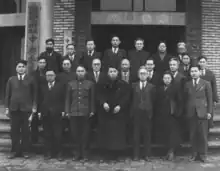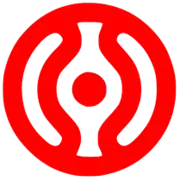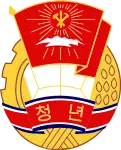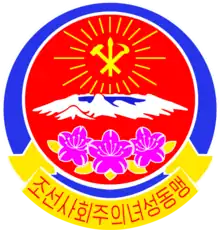Democratic Front for the Reunification of Korea
The Democratic Front for the Reunification of Korea, also known as the Democratic Front for the Reunification of the Fatherland (DFRF) or the Fatherland Front, is a North Korean popular front formed on 22 July 1946 and led by the Workers' Party of Korea (WPK).[2] It was initially called the North Korean Fatherland United Democratic Front.[3]
Democratic Front for the Reunification of Korea 조국통일민주주의전선 | |
|---|---|
| Supreme Leader | Kim Jong Un |
| Director | Maeng Kyong-il |
| Founder | Kim Il Sung |
| Founded | 22 July 1946 |
| Headquarters | Pyongyang |
| Ideology | |
| Political position | Far-left[B] |
| Supreme People's Assembly | 687 / 687 |
^ A: A number of scholars, such as B. R. Myers and Michael J. Seth, argue that the ideology of Workers' Party of Korea, which leads the DFRK has little in common with communism, despite the party's official stance. ^ B: B. R. Myers describes the Workers' Party of Korea as far-right due to its emphasis on Korean ethnic nationalism.[1] | |
| Democratic Front for the Reunification of Korea | |
| Chosŏn'gŭl | 조국통일민주주의전선 |
|---|---|
| Hancha | |
| Revised Romanization | Joguk Tong(-)il Minju Juui Jeonseon |
| McCune–Reischauer | Choguk T'ongil Minju Chuŭi Chŏnsŏn |
Initially 72 parties and social organizations,[4] from both the North and the South, comprised the front.[5] Today it has 24 members.[4] The three political parties of North Korea—the WPK, the Korean Social Democratic Party, and the Chondoist Chongu Party—all participate in the front.[6] The four most important mass organizations—the Socialist Patriotic Youth League, Socialist Women's Union of Korea, General Federation of Trade Unions of Korea, and Union of Agricultural Workers of Korea—are also members.[7][8] The Korean Children's Union is also a member organization.[9]
All candidates for elective office must be members of the front, and are elected by it; mass meetings are held to decide which candidates will be nominated and their names can go on the ballot paper only with the approval of the meeting.[10] In practice, however, the minor parties and mass organizations in the front are completely subservient to the WPK.[11] The WPK is thus able to predetermine the composition of the Supreme People's Assembly (SPA).
There is an ostensible South Korean counterpart for the DFRK, known as the Anti-Imperialist National Democratic Front, which operates in North Korea.
The current Director of the Secretariat of the Central Committee of the DFRK is Maeng Kyong-il. Members of the Presidium of the Central Committee include Pak Myong-chol and Kim Wan-su.[12]
History

The South Korean National Democratic Front was founded with the Communist Party of Korea at its centre on 15 February 1946. It was formed from 40 leftist parties and consisted of 398 communists led by Lyuh Woon-hyung, Pak Hon-yong, and Ho Hon. The North Korean National Democratic Front was founded with the Workers' Party of North Korea at its centre on 22 July 1946. It was formed from 13 organizations and led by Kim Il Sung, Kim Tu-bong, and Choe Yong-gon. The North Korean National Democratic Front absorbed the South Korean National Democratic Front on 25 June 1949, after South Korea outlawed the latter.[13]
In 2018, DFRK had Pak Myong-chol as its leader.[14] Presidium members during that time included Ri Kil-song and Kim Wan-su.[15]
Members
Political parties
| Name (abbreviation) |
Emblem | Ideology | Leader | Foundation | Seats in the SPA (2014) | Ref | |
|---|---|---|---|---|---|---|---|
| Workers' Party of Korea 조선로동당 Chosŏn Rodongdang |
 |
Kimilsungism–Kimjongilism | Kim Jong Un | 29 July 1946 | 607 / 687 |
[16][17] | |
| Korean Social Democratic Party 조선사회민주당 Chosŏn Sahoe Minjudang |
 |
Social democracy (de jure) |
Vacant | 3 November 1945 | 50 / 687 |
[18][17] | |
| Chondoist Chongu Party 천도교청우당 Ch'ŏndogyo Ch'ŏngudang |
 |
Chondoist interests | Ri Myong-chol | 18 February 1946 | 22 / 687 |
[19][17] | |
| Chongryon[lower-alpha 1] 총련 |
Zainichi interests | Pak Ku-ho | 30 March 1955 | 6 / 687 |
[20] | ||
Other organizations
| Organization | Emblem | Korean name | Foundation | Ref |
|---|---|---|---|---|
| Socialist Patriotic Youth League |  |
사회주의애국청년동맹 | 17 January 1946 | [21] |
| Socialist Women's Union of Korea |  |
조선사회주의녀성동맹 | 18 November 1945 | [22] |
| General Federation of Trade Unions of Korea |  |
조선직업총동맹 | 30 November 1945 | [23] |
| Union of Agricultural Workers of Korea |  |
조선농업근로자동맹 | 31 January 1946 | [23] |
| Korean Children's Union |  |
조선소년단 | 6 June 1946 | [24] |
| Korean Journalists' Union | 조선기자동맹 | 10 February 1946 | [25][26] | |
| Korean Federation of Literature and Arts | 조선문학예술총동맹 | 25 March 1946 | [25][27] | |
| Korean Christian Federation | 조선그리스도교연맹 | 28 November 1946 | [28][29] | |
| Korean Catholic Association | 조선카톨릭교협회 | 30 June 1988 | [30][31] | |
| Korea Buddhist Federation | 조선불교도련맹 | 26 December 1945 | [30][32] | |
| Chosun Cheondogyo Central Guidance Committee | 조선천도교중앙지도위원회 | 1 February 1946 | [30][33] |
Electoral history
Supreme People's Assembly elections
| Election | % of votes | Seats | +/− | Position | Government |
|---|---|---|---|---|---|
| 1948 | 98.49% | 572 / 572 |
Sole legal coalition
under the control of WPK | ||
| 1957 | 99.92% | 215 / 215 |
|||
| 1962 | 100% | 383 / 383 |
|||
| 1967 | 100% | 457 / 457 |
|||
| 1972 | 100% | 541 / 541 |
|||
| 1977 | 100% | 579 / 579 |
|||
| 1982 | 100% | 615 / 615 |
|||
| 1986 | 100% | 655 / 655 |
|||
| 1990 | 100% | 687 / 687 |
|||
| 1998 | 100% | 687 / 687 |
|||
| 2003 | 100% | 687 / 687 |
|||
| 2009 | 100% | 687 / 687 |
|||
| 2014 | 100% | 687 / 687 |
|||
| 2019 | 100% | 687 / 687 |
Notes
- Chongryon is not a political party but sends members to the Supreme People's Assembly to represent the organisation as part of the Democratic Front.
References
Citations
- Myers 2011, pp. 9, 11–12.
- "Democratic Front for the Reunification of the Fatherland". Naenara.kp. 2004. Archived from the original on 4 December 2008.
- Andrei N. Lankov (2001). "The Demise of Non-Communist Parties in North Korea (1945–1960)". jhu.edu. Retrieved 8 September 2015.
- 조국통일민주주의전선(조국전선) - 개요. nk.chosun.com (in Korean). 30 October 2010. Retrieved 8 February 2019.
- "Korea". The Great Soviet Encyclopedia (3rd ed.). 1970–1979. Retrieved 25 October 2018.
- "Democratic Front for the Reunification of the Fatherland". An Encyclopedic Dictionary of Marxism, Socialism and Communism: Economic, Philosophical, Political and Sociological Theories, Concepts, Institutions and Practices. Macmillan International Higher Education. 1981. p. 141. ISBN 978-1-349-05806-8.
- Scalapino, Robert A.; Chun-yŏp Kim (1983). North Korea Today: Strategic and Domestic Issues. Institute of East Asian Studies, University of California, Berkeley, Center for Korean Studies. p. 84. ISBN 978-0-912966-55-7.
- Lansford, Tom (2015). Political Handbook of the World 2015. Singapore: CQ Press. p. 3330. ISBN 978-1-4833-7155-9.
- "Korea, Democratic People's Republic of (DPRK) - Organizations". Retrieved 31 August 2006.
- "The Parliamentary System of the Democratic People's Republic of Korea" (PDF). Constitutional and Parliamentary Information. Archived from the original (PDF) on 19 August 2006. Retrieved 1 October 2006.
- Savada, Andrea Matles. "Mass Organizations." North Korea: A country study. Washington: GPO for the Library of Congress, 1993.
- "Foundation Day of Korea Marked". Korean Central News Agency. 4 October 2022. Retrieved 1 January 2023.
- "조국통일민주주의전선". Encyclopedia of Korean Culture.
- "Vietnam's Party, State delegation visits DPRK". Nhân Dân. NDO/VNA. 10 September 2018. Retrieved 19 February 2019.
- "National Foundation Day Marked". KCNA Watch. Uriminzokkiri. 5 October 2018. Retrieved 19 February 2019.
- Lanʹkov, Andreĭ Nikolaevich (2002). From Stalin to Kim Il Song: The Formation of North Korea, 1945-1960. C. Hurst & Co. Publishers. p. 31. ISBN 978-1-85065-563-3.
- "IPU PARLINE Database: Democratic People's Republic of Korea, Choe Go In Min Hoe Ui". Inter-Parliamentary Union.
- North Korea Handbook 2002, p. 1128.
- Tertitskiy, Fyodor (26 November 2014). "Being a minor party in the North: In a totalitarian regime, what do N. Korea's other political blocs do?". NK News. Retrieved 25 May 2018.
- "No re-entry for Chongryon execs who go to Kim's funeral". Asahi Shimbun. 23 December 2011. Archived from the original on 23 June 2013.
- North Korea Handbook 2002, p. 391.
- North Korea Handbook 2002, p. 390.
- North Korea Handbook 2002, p. 389.
- North Korea Handbook 2002, p. 929.
- 조국통일민주주의전선(祖國統一民主主義戰線). Encyclopedia of Korean Culture (in Korean). Archived from the original on 22 August 2019. Retrieved 8 February 2019.
- Lent, John A. (1982). Newspapers in Asia: Contemporary Trends and Problems. Hong Kong: Heinemann Asia. p. 127. ISBN 978-962-225-079-6.
- North Korea Handbook 2002, p. 1121.
- 조국통일민주주의전선. North Korea Information Portal (in Korean). Ministry of Unification. Retrieved 13 October 2019.
- Hoare, James (2012). Historical Dictionary of Democratic People's Republic of Korea. Lanham: Scarecrow Press. p. xxix. ISBN 978-0-8108-6151-0.
- <통일부 수탁과제 최종보고서> 북한개요 개정판 (in Korean). 통일부. 24 December 2008. p. 49. Retrieved 31 January 2021.
- Kwon Oh-guk (2013). "script-ko:조선카톨릭협회(朝鮮카톨릭協會)". Encyclopedia of Korean Culture (in Korean). Retrieved 31 January 2021.
- Ryu Gil-jae (2009). 조선불교도연맹(朝鮮佛敎徒聯盟). encykorea.aks.ac.kr (in Korean). Retrieved 31 January 2021.
- Kwon Oh-guk (2013). 조선천도교중앙지도위원회(朝鮮天道敎中央指導委員會). Encyclopedia of Korean Culture (in Korean). Retrieved 31 January 2021.
Sources
- Myers, Brian (2011). The Cleanest Race: How North Koreans See Themselves and Why it Matters. Melville House Publishing. ISBN 978-1933633916.
- North Korea Handbook. Seoul: Yonhap News Agency. 2002. ISBN 978-0-7656-3523-5.